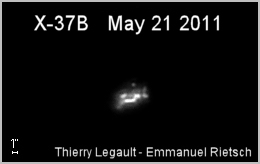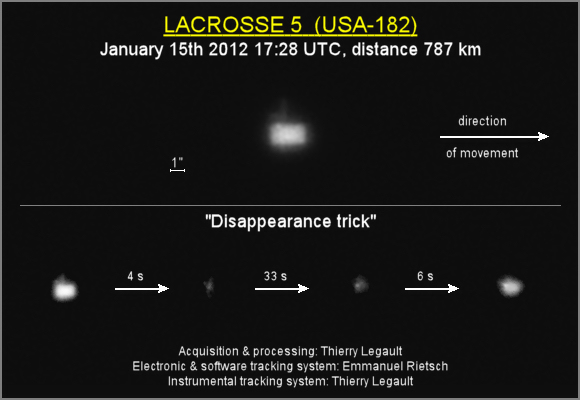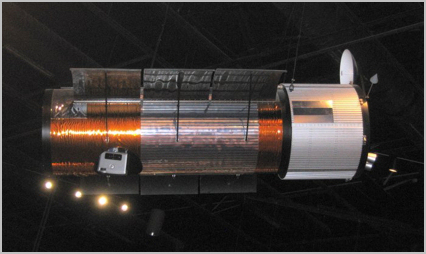
SPY SATELLITES
|
Any use of one of these images other than strictly private must be subject to prior authorization from legault@astrophoto.fr All the images and videos below have been taken with a 10”
telescope on automatic tracking system, as described on
this
page. X-37B confidential
USAF shuttle Lacrosse-5 radar reconnaissance satellite USA-186
(Keyhole KH-13 series) Hubble-type optical reconnaissance satellite |
X-37B
confidential USAF shuttle
| This video of the second X-37B (OTV-2) has been taken from southern France on May 21st 2011 at 2:18 UTC. Distance to observer: 341 km (212 miles). Angular speed at culmination: 1.3°/s. The speed of the sequence is accelerated two times with regard to real time. |

Downloadable
DivX file (for private show only).
The Boeing X-37B (also called OTV for Orbital Test Vehicle) is
an unmanned vertical take-off, horizontal landing spaceplane operated by the
USAF as a demonstrator for reusable space technologies. Like the Space Shuttle,
it features wings, a payload bay and a thermal protection shield, but at van
size: its length is only 29 feet (8.8 m), versus 122 feet (35 m) for the
Shuttle. It also uses a deployable solar panel. The OTV-2 (USA-226) has been
launched on March 5th 2011.

| Below, a video taken the day before (May 20th) showing in real
time a flare occurring around 3:33:08 UTC. |
Downloadable
DivX file (for private show only). Lacrosse-5 (USA-182)
radar reconnaissance satellite
This video of Lacrosse 5 has been taken from the area of Paris on January 15th 2012 at
17:28 UTC. Distance to observer: 787 km (490
miles). Angular speed at culmination: 0.53°/s. The video is shown in original
acquisiton scale and is accelerated two times with regard to real
time. The image below is a combination of 100 raw images and is enlarged
by 200%.
During the passage, the brightness of the satellite decreases by
10 times in 4 seconds (a loss of 2.5 magnitude), and after 33 seconds regains
its original level in about 6 seconds. This satellite often shows this very
singular behaviour (sudden loss of brightness can affect a tumbling satellite,
but this is not the case here), even the other Lacrosse satellites do not share
it. It is called by the observers (especially
Marco
Langbroek) the "disappearance trick". Its cause, as
well as the precise shape of the satellite, remain unknown.

Downloadable
DivX file (for private show only).
Lockheed-Martin Lacrosses are military imaging reconnaissance
satellites equipped with an aperture synthesis radar. Size is 13 m by 4.5 m (42
by 14 feet), Photo below (from
GlobalSecurity).
USA-186
(Keyhole KH-13 series) Hubble-type optical reconnaissance satellite
| This video of USA-186 close to perigee has been taken on May 25th 2011 at 21:02 UTC. Distance to observer: 316 km (196
miles). Angular speed at culmination: 1.4°/s. The speed of the sequence is accelerated two times with regard to real
time. A strong flare occurs around 21:02:00 at the end of the body of the
satellite, just after a smaller flare just beside on the communication dish (see
photo below). |

Downloadable
DivX file (for private show only).
|
Keyhole military satellites (Improved Crystal program) are used
for optical high-resolution observation of the ground. They are often compared
to the Hubble Space Telescope. Their orbit can be very elliptical (apogee about 1000 km, perigee under 300 km). Below a mock-up of a KH-12 series satellite (from www.GlobalSecurity.org). Assuming that the KH-13 satellites are similar, the flares come from reflection of the Sun on the brightest and larger end of the satellite (right) and the communication dish. |

Lacrosse-3
radar reconnaissance satellite
| This video of Lacrosse-3 (USA-133) has been taken on April 6th 2011 at 20:09 UTC. Distance to observer: 661 km (411 miles). Angular speed at culmination: 0.7°/s. The speed of the sequence is accelerated two times with regard to real time. A flare occurs around 20:09:30 UTC. |

Downloadable DivX file (for private show only).
| Lockheed-Martin Lacrosses are military imaging reconnaissance satellites equipped with an aperture synthesis radar. Size is 13 m by 4.5 m (42 by 14 feet), with a 30 to 45 m long solar array (100 to 150 feet), not including the radar antenna (either a single semi circular or two white gold semi ellipsoidal open mesh dishes). According to the Lacrosse-1 drawing below (from GlobalSecurity), the features visible on the video are the two parts of the solar array and the big dish antenna. |